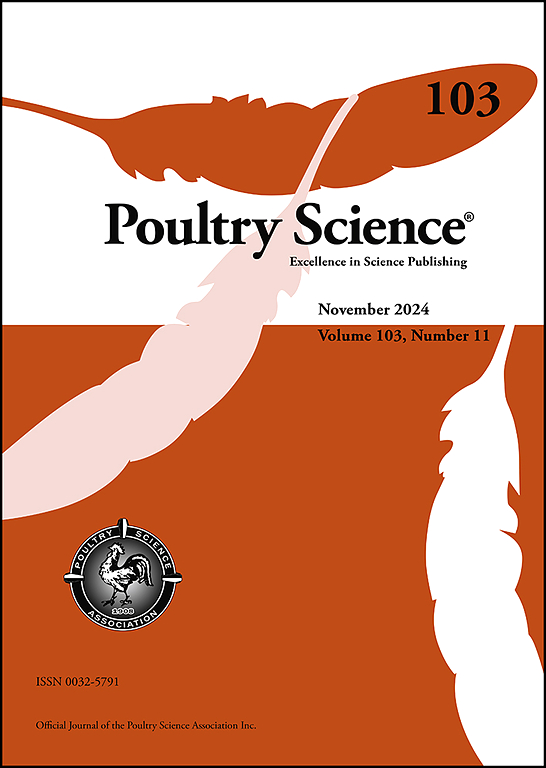Matrine disturbs the eimeria necatrix-induced loop of tuft cell-intestinal stem cell-goblet cell by inactivating IL-13/JAK2/STAT3 signaling
IF 3.8
1区 农林科学
Q1 AGRICULTURE, DAIRY & ANIMAL SCIENCE
引用次数: 0
Abstract
As sensors in the gut, tuft cells integrate a complex array of luminal signals to regulate the differentiation fate of intestinal stem cells (ISCs), which trigger a loop of tuft cell-ISC-goblet cell after parasitic infection. As a plant-derived alkaloid, Matrine plays a prominent role for standardizing ISC functions in Eimeria necatrix (EN)-exposed chicks. In this study, we investigated the modulation effects of Matrine on the specific intestinal epithelial cell loop in EN-exposed chicks in vivo and intestinal organoids (IOs) ex vivo. The results showed that EN infection resulted in swelling and hemorrhage of the jejunum, accompanied by the increase in levels of sIgA and inflammatory cytokines (IL-6, IL-1β, and TNF-α). And these inflammatory symptoms were effectively relieved by Matrine intervention. Concurrently, Matrine resisted the EN-induced increase in tuft cell numbers and levels of crucial pro-inflammatory factors (IL-25 and IL-13), while also reversing the differentiation of secretory cell progenitors into goblet cells. Importantly, Matrine impeded the upregulation of the inflammatory signaling pathway JAK2/STAT3 in EN-infected chicks and IOs. Conversely, exogenous supplementation of IL-13 or activation of STAT3 via Colivelin eliminated the standardization of the tuft cell-ISC-goblet cell loop by Matrine. Overall, our findings suggested that Matrine intercepted the tuft cell-ISC-goblet cell loop by reinstating IL-13/JAK2/STAT3 signaling after EN infection.
苦参碱通过灭活IL-13/JAK2/STAT3信号通路干扰丛状细胞-肠干细胞-杯状细胞艾美球虫诱导的细胞环。
作为肠道中的传感器,簇毛细胞整合一系列复杂的管腔信号来调节肠道干细胞(ISCs)的分化命运,从而在寄生虫感染后触发簇毛细胞- ISCs -杯状细胞的循环。苦参碱是一种植物源性生物碱,在美耳美球虫(EN)暴露雏鸡ISC功能标准化中起着重要作用。本研究研究了苦参碱对en暴露雏鸡体内和离体肠道类器官(IOs)特异性肠上皮细胞环的调节作用。结果显示,EN感染引起大鼠空肠肿胀出血,并伴有sIgA和炎性细胞因子(IL-6、IL-1β、TNF-α)水平升高。苦参碱干预能有效缓解炎症症状。同时,苦参碱抑制en诱导的簇状细胞数量和关键促炎因子(IL-25和IL-13)水平的增加,同时逆转分泌细胞祖细胞向杯状细胞的分化。重要的是,苦参碱抑制了en感染雏鸡和IOs中炎症信号通路JAK2/STAT3的上调。相反,外源补充IL-13或通过Colivelin激活STAT3消除了参碱对簇状细胞- isc -杯状细胞环的标准化。总之,我们的研究结果表明,在EN感染后,苦参碱通过恢复IL-13/JAK2/STAT3信号通路来阻断簇状细胞- isc -杯状细胞环。
本文章由计算机程序翻译,如有差异,请以英文原文为准。
求助全文
约1分钟内获得全文
求助全文
来源期刊

Poultry Science
农林科学-奶制品与动物科学
CiteScore
7.60
自引率
15.90%
发文量
0
审稿时长
94 days
期刊介绍:
First self-published in 1921, Poultry Science is an internationally renowned monthly journal, known as the authoritative source for a broad range of poultry information and high-caliber research. The journal plays a pivotal role in the dissemination of preeminent poultry-related knowledge across all disciplines. As of January 2020, Poultry Science will become an Open Access journal with no subscription charges, meaning authors who publish here can make their research immediately, permanently, and freely accessible worldwide while retaining copyright to their work. Papers submitted for publication after October 1, 2019 will be published as Open Access papers.
An international journal, Poultry Science publishes original papers, research notes, symposium papers, and reviews of basic science as applied to poultry. This authoritative source of poultry information is consistently ranked by ISI Impact Factor as one of the top 10 agriculture, dairy and animal science journals to deliver high-caliber research. Currently it is the highest-ranked (by Impact Factor and Eigenfactor) journal dedicated to publishing poultry research. Subject areas include breeding, genetics, education, production, management, environment, health, behavior, welfare, immunology, molecular biology, metabolism, nutrition, physiology, reproduction, processing, and products.
 求助内容:
求助内容: 应助结果提醒方式:
应助结果提醒方式:


